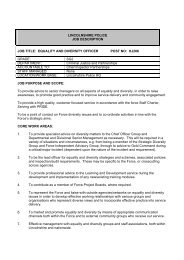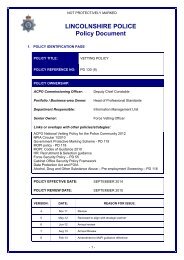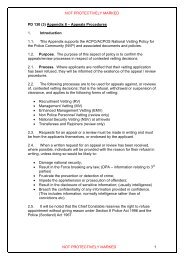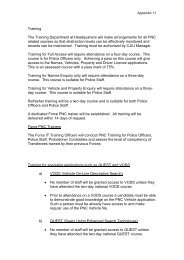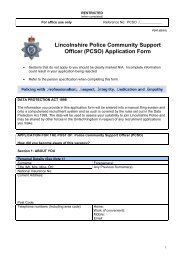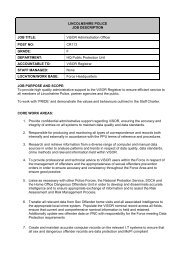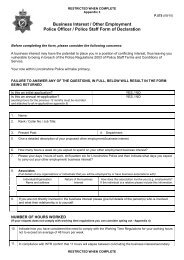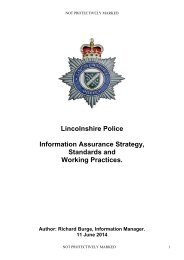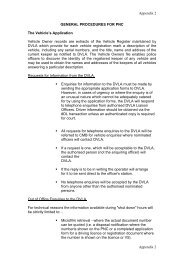Engagement Strategy 2009-2012.pdf - Lincolnshire Police
Engagement Strategy 2009-2012.pdf - Lincolnshire Police
Engagement Strategy 2009-2012.pdf - Lincolnshire Police
Create successful ePaper yourself
Turn your PDF publications into a flip-book with our unique Google optimized e-Paper software.
LINCOLNSHIRE POLICE<br />
policing with PRIDE<br />
ENGAGEMENT<br />
STRATEGY<br />
<strong>2009</strong> - 2012
Contents<br />
Introduction . . . . . . . . . . . . . . . . . . . . . . . . . . . . . . . . . . . . . . . . . 1<br />
<strong>Engagement</strong> Belongs to Everyone . . . . . . . . . . . . . . . . . . . . . . . 2<br />
Definition of <strong>Engagement</strong> and Community . . . . . . . . . . . . . . . . 3<br />
Why We Must Engage . . . . . . . . . . . . . . . . . . . . . . . . . . . . . . . . . 4<br />
Who We Engage With . . . . . . . . . . . . . . . . . . . . . . . . . . . . . . . . . . 4<br />
How We Engage . . . . . . . . . . . . . . . . . . . . . . . . . . . . . . . . . . . . . . 5<br />
<strong>Engagement</strong> Delivery Plans - Implementation Issues . . . . . . . . 6<br />
Managing <strong>Engagement</strong> – The Cycle of <strong>Engagement</strong> . . . . . . . . . 7
Joint <strong>Engagement</strong> <strong>Strategy</strong><br />
Introduction<br />
One of the<br />
fundamental<br />
principles of good<br />
policing in<br />
<strong>Lincolnshire</strong> is that<br />
we truly listen to<br />
the public that we<br />
serve and provide<br />
them with a<br />
service which<br />
meets their needs<br />
and expectations.<br />
How, when and<br />
where we connect<br />
with people is<br />
crucial, and I want<br />
us to use every<br />
opportunity to be creative in finding new and<br />
effective ways of building a positive and meaningful<br />
relationship with communities.<br />
If we do this well then we will be far better placed to<br />
ensure that people receive the right type of service<br />
from us. We will also have effective opportunities to<br />
inform them of things that we are doing on their<br />
behalf to help keep them safe and secure in their<br />
communities. This will enable us to discuss those<br />
things that really matter to people and to<br />
strengthen the relationship between police and<br />
public which is so important to building increased<br />
trust and confidence.<br />
This strategy outlines how we can achieve better<br />
engagement with people and I commend it to you.<br />
Community<br />
engagement gives<br />
the people of<br />
<strong>Lincolnshire</strong> a more<br />
significant voice in<br />
policing. The <strong>Police</strong><br />
Authority and the<br />
Force are working<br />
hard to ensure that<br />
local communities<br />
and local<br />
accountability are at<br />
the heart of policing<br />
in the county, and<br />
that the police are<br />
responsive to the<br />
public’s needs.<br />
The Authority is responsible for ensuring and<br />
overseeing the effectiveness and efficiency of the<br />
Force. We must also ensure open and constructive<br />
procedures are in place to allow the public to<br />
influence and shape their policing requirements.<br />
The Authority will make sure that clear systems to<br />
monitor and scrutinise the outcomes of community<br />
engagement are put in place.<br />
We recognise that it is only through working<br />
together with our communities, and by encouraging<br />
their active engagement, that we can help deliver a<br />
service that meets the needs of local people.<br />
The purpose of this <strong>Engagement</strong> <strong>Strategy</strong> is to<br />
enable our partners, our staff and the wider public<br />
to understand the responsibility of the Authority and<br />
the Force for community engagement and to set out<br />
how we will safeguard and strengthen local<br />
involvement.<br />
Chief Constable<br />
Richard Crompton<br />
Chairman<br />
Councillor Barry Young<br />
1
Public Service and Confidence<br />
<strong>Engagement</strong> Belongs to Everyone<br />
“<br />
By consulting with our Neighbourhood Management Team<br />
in relation to public surveys, these results help us to focus on<br />
working towards what local residents want in the area<br />
”<br />
PCSO Debbie Adams<br />
<strong>Engagement</strong> helps us to listen, learn and improve our service<br />
“<br />
I am a member of the Neighbourhood Panel and by working<br />
closely with other panel members and the <strong>Police</strong> we were<br />
able to identify problems and work towards a solution<br />
Beryl Giblett (Chair of the Abbey Neighbourhood Panel)<br />
<strong>Engagement</strong> helps people to get involved and empowers local action<br />
”<br />
“<br />
I have recently been a victim of crime and the <strong>Police</strong> dealt<br />
with this very professionally given that it was a sensitive<br />
case. I was very impressed with the information that was<br />
initially given to me and can only pass on my thanks to those<br />
people who were involved in the investigation<br />
<strong>Engagement</strong> keeps people informed and increases confidence<br />
Wendy Shaw (local resident)<br />
”<br />
2
Joint <strong>Engagement</strong> <strong>Strategy</strong><br />
Definition of <strong>Engagement</strong> and Community<br />
Our Definition of <strong>Engagement</strong> – The ‘Three Strands’<br />
‘<strong>Engagement</strong>’ means:-<br />
Informing<br />
Inclusive methods of communication and access to information<br />
Information, communication and reassurance<br />
Consulting<br />
Participating<br />
Inclusive opportunities for people as stakeholders to influence,<br />
including listening to and acting on feedback<br />
Listening, monitoring and accountability<br />
Inclusive methods of empowerment and participation (active<br />
citizenship) in community and public service development and<br />
action.<br />
Partnership, co-operation, empowerment and co-production<br />
Our Definition of Community<br />
‘Community’ means a group of people who share things in common such as:<br />
●●●<br />
●●●<br />
Geographical place, local area of residence, employment, business<br />
Interest or identity, such as ethnicity, sexuality, gender, age, disability, religion / faith or agenda based<br />
communities<br />
WHO THE STRATEGY IS FOR<br />
Who is involved in this strategy Who are the stakeholders<br />
We use the term ‘Stakeholders’ because engagement involves many different groups of people. Within this<br />
strategy the term is used to describe people :-<br />
INTERNALLY<br />
EXTERNALLY<br />
EXTERNALLY<br />
within the Force and Authority<br />
(For example: Staff, Members, Volunteers, etc)<br />
members of public within local communities<br />
(For example: Residents, Businesses, Elected Members, Independent Advisory<br />
Groups (IAGs), Community Groups or Leaders, Voluntary Sectors, etc)<br />
within the partner agencies<br />
(For example: Local Authorities, Community Safety Partnerships, Road Safety<br />
Partnerships, Local Strategic Partnerships, <strong>Lincolnshire</strong> Assembly, <strong>Lincolnshire</strong><br />
Criminal Justice Board (LCJB), Voluntary Sectors, etc)<br />
3
Public Service and Confidence<br />
Why We Must Engage<br />
The purpose of this strategy is to offer direction for engagement. This document explores the:-<br />
Why Where When Who How<br />
It also links to the cycle of engagement, which will inform a delivery plan and review process for engagement<br />
What are the BENEFITS<br />
By investing in engagement, we can develop the<br />
related work streams that will build on our<br />
relationships with stakeholders. These<br />
relationships are essential in identifying ways to<br />
improve, deliver and evaluate our public service,<br />
performance and business planning.<br />
Information and Consultation will develop higher<br />
levels of trust, knowledge, understanding,<br />
legitimacy, influence and respect.<br />
Participation will develop ‘active citizenship’<br />
(including active employment / active partnership).<br />
This is about building relationships and actively<br />
tackling problems or making improvements<br />
together.<br />
Empowering stakeholders to get involved in<br />
appropriate areas of decision-making aims to<br />
improve policy development and service delivery.<br />
We aim to achieve this through our inclusion of<br />
direct, real experience from stakeholders,<br />
considering the broader perspective of everybody<br />
involved in the service relationship and sharing the<br />
responsibility and ownership for service issues.<br />
Stakeholder participation aims to provide the<br />
utmost levels of accountability through direct<br />
involvement. It is not just about asking for advice<br />
and opinion, it is also about showing trust (in) and<br />
respect (for) stakeholders and their ability to be<br />
involved in making decisions about the services<br />
that they have or will need to access.<br />
Where, When and Who We Engage With<br />
<strong>Engagement</strong> should be as inclusive as possible. We<br />
aim to consider all possible methods of providing<br />
engagement opportunities that are flexible to<br />
communities and individuals based on geography,<br />
interest and identity. This is to ensure that when and<br />
where we engage best meets the needs of our<br />
stakeholders.<br />
We will work in partnership to establish opportunities<br />
to use community profiling, mapping, socio-economic<br />
data and other marketing based resources to help<br />
identify our target audiences for engagement. (See<br />
Force Communication <strong>Strategy</strong> for further information<br />
on how to communicate with target audiences).<br />
We aim to develop work streams that pay particular<br />
attention to establishing a connection with hard to<br />
hear / hard to reach groups through existing and new<br />
relationships established within the public and<br />
commercial service sector.<br />
4
Joint <strong>Engagement</strong> <strong>Strategy</strong><br />
How We Engage<br />
We have a vision to deliver our services for Policing with PRIDE (Professionalism, Respect, Integrity,<br />
Dedication, Empathy). The Force and Authority also have shared and separate responsibilities in relation to<br />
engagement requirements (statutory and aspirational). As such, separate delivery plans will be produced.<br />
Each delivery plan will consider the following areas which impact on ‘how’ we engage with stakeholders.<br />
What types of engagement will we consider<br />
and use<br />
We aim to develop an engagement toolkit for<br />
practitioners which will provide the guidance, skills<br />
and materials required to deliver engagement using<br />
different techniques.<br />
We aim to monitor and evaluate different<br />
techniques, and consult with stakeholders in<br />
relation to the effectiveness of each technique to<br />
inform future development.<br />
We aim to develop ways to help external<br />
stakeholders identify, understand, and access the<br />
most suitable engagement opportunities.<br />
Levels of engagement<br />
We aim to do more to manage and co-ordinate<br />
engagement at national, regional, force /authority,<br />
BCU, sector and neighbourhood levels.<br />
Mapping engagement<br />
We aim to map engagement activity at all levels and<br />
regularly maintain and publish this knowledge to<br />
ensure that stakeholders are informed or able to<br />
access engagement opportunities.<br />
Sharing effective practice in engagement<br />
We aim to develop more formal methods for sharing<br />
such effective practice at different levels internally<br />
and externally. This could also include working with<br />
commercial industries to understand how they<br />
engage with their customers.<br />
What are the minimum standards for<br />
engagement<br />
In line with minimum standards for quality of<br />
service, the Quality of Service Commitment, we aim<br />
to develop basic standards for all internal<br />
stakeholders to incorporate in to their core role,<br />
regardless of their business area.<br />
How do we consult on engagement<br />
We aim to develop a better understanding and<br />
appreciation of stakeholders preferences in relation<br />
to the engagement methods, times, venues,<br />
samples / audiences selected.<br />
By understanding engagement preferences, we can<br />
be more flexible with stakeholders and increase our<br />
volume of information, consultation and<br />
participation activities.<br />
5
Public Service and Confidence<br />
Delivering <strong>Engagement</strong> - Implementation<br />
ENGAGEMENT DELIVERY PLANS<br />
We recognise the challenges of implementing engagement delivery plans.<br />
We aim to develop engagement work streams that consider the following implementation issues.<br />
●●●<br />
●●●<br />
●●●<br />
●●●<br />
●●●<br />
●●●<br />
●●●<br />
●●●<br />
●●●<br />
●●●<br />
Organisational Commitment and Cultural Change<br />
Mainstreaming <strong>Engagement</strong><br />
Empowerment – Internal / External participation<br />
Tailoring and Flexibility<br />
Performance Management – focus on quality<br />
Training and Capacity Building<br />
Confidence and Trust – Building relationships<br />
Communication - Two-way dialogue – Feedback and good quality information<br />
Partnership Working<br />
Resources<br />
6
Joint <strong>Engagement</strong> <strong>Strategy</strong><br />
Managing <strong>Engagement</strong> – The Cycle of<br />
Confidence and <strong>Engagement</strong><br />
We aim to provide a direction for the delivery of engagement based on the Neighbourhood Policing model of<br />
Access, Influence, Interventions and Answers. This model is relevant to any stakeholder involved in the<br />
engagement process and provides a simple process to ensure all activity is open, inclusive, empowering,<br />
active, informed and evaluated.<br />
ACCESS<br />
Establishing How, Where, When, Why and with Whom<br />
stakeholders can connect with through ENGAGEMENT<br />
INFLUENCE<br />
Being clear about what our stakeholders should expect, how<br />
much and where they can have a voice and how their voices<br />
can make a difference through ENGAGEMENT<br />
INTERVENTIONS<br />
Solving problems and implementing actions to improve<br />
services through ENGAGEMENT.<br />
ANSWERS<br />
Making sure stakeholders know how they have made a<br />
difference to the services they are or may be involved with<br />
through ENGAGEMENT and feedback.<br />
ENGAGEMENT<br />
Feedback from<br />
stakeholders<br />
Identify areas for<br />
improvement<br />
Activity through NIM<br />
and Business Planning<br />
THE CYCLE OF<br />
CONFIDENCE AND<br />
ENGAGEMENT<br />
Solving Problems /<br />
Improving Services<br />
Together<br />
Community<br />
Intelligence and Public<br />
Service Intelligence<br />
Inspire Trust<br />
Build Confidence<br />
7



